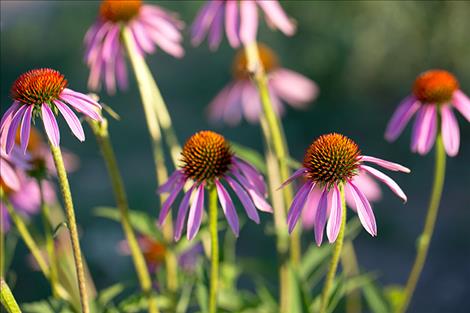Some native perennials to plant in fall
Hey savvy news reader! Thanks for choosing local.
You are now reading
1 of 3 free articles.
Fall is a very good time to plant potted perennial plants. Garden soil is still warm, enabling roots to grow quickly, therefore allowing perennial plants to establish well. Root growth will take place all through the autumn, finally ceasing when the ground freezes in mid-November or even in December, depending on the year. In autumn fewer weeds germinate so it is easier to keep beds clean while newly planted perennials establish themselves. Fall planting ensures a heavier spring or summer bloom, too. These same factors apply to the many kinds of bulbs we plant in fall. Below is a list of excellent plants for Western Montana, including native wildflowers and some drought-tolerant perennials.
Butterfly Weed Asclepias tuberosa 18 inches - 2 ft. x 2 ft. wide (plant in full sun) zones 3-9. This native plant blooms in summer with bright orange flowers which are an important nectar source for bees and butterflies. The leaves are important as a nursery for Monarch butterfly larvae. Butterfly weed grows well in dry, poor soils so it needs less water than most garden perennials.
Coreopsis Coreopsis grandiflora 18 – 30 inches x 2 ft. wide (plant in full sun) zones 3-9. Coreopsis is another native perennial that blooms for a long season, from early summer into fall. The flowers are brilliant yellow and attract butterflies and bees. Coreopsis likes a little more water than butterfly weed, but is drought tolerant once established. It is quite easy to grow.
Echinacea Echinacea purpurea 3-4 ft. x 3 ft. wide (plant in full sun) zones 3-9. This coneflower is native to the eastern half of the U.S. where it grows in dry woods and tall grass prairies. Once established, coneflower is drought tolerant, needing about as much water as coreopsis. The roots are used medicinally. Flowers of the wild form are of soft purple and the bloom period lasts for months, beginning in mid-summer. Echinacea is another excellent pollinator plant, attracting bees and butterflies.
Echinacea Echinacea angustifolia 18 inches - 2 ft. x 2 ft. wide (plant in full sun) zones 3-9. This native echinacea prefers drier conditions than E. purpurea so is very well-adapted to our dry summers. The plants are a bit smaller also. The roots are used medicinally and the flowers are an excellent nectar source for bees and butterflies. Flowering period is early through late summer.
Blazing Star Liatris spicata 30 x 18 inches wide (plant in full sun) zones 3-9. A wonderful native plant with soft purple plumes of long-lasting flowers that attract bees and butterflies. The flowers can be used for cutting and last a long time. Plants are easy to grow, needing about as much water as coreopsis, lupine and Echinacea purpurea.
Lupine Lupinus polyphyllus (Minarette Dwarf Hybrids) 16 x 16 inches wide (plant in full sun) zones 3-9. Minarette hybrid lupines are descended from a species native to Montana. They are very well-adapted to our climate and attract bees, butterflies and hummingbirds. Flower colors of this strain of lupine are beautiful and include bicolor forms as well. The plants flower in June-July.
Monarda fistulosa 2 ft. x 2 ft. wide (plant in full sun) zones 3-9. The common names for this plant are bee balm and wild bergamot. This species is native to North America and has showy white to purple flowers that attract hummingbirds, bees and butterflies. This wild species prefers a moist soil, where it will bloom larger and longer in mid to late summer.
Bee Balm Monarda didyma Panorama Hybrids 30 x 30 inches wide (plant in full sun) zones 3-9. These hybrids of a native eastern U.S. species are colorful, fragrant and attract hummingbirds, bees and butterflies. Colors range from pink to red, burgundy, scarlet, purple and white. Flowers appear July-September. Bee balm likes a moist soil; the same conditions as M. fistulosa.
Mexican Hat Ratibida columnifera 12 – 36 inches x 18 inches wide (plant in full sun) zones 3-9. The flowers of this native species look like a little orange and yellow sombrero. The plants are drought tolerant and easy to grow. Bees and butterflies love the flowers.
















